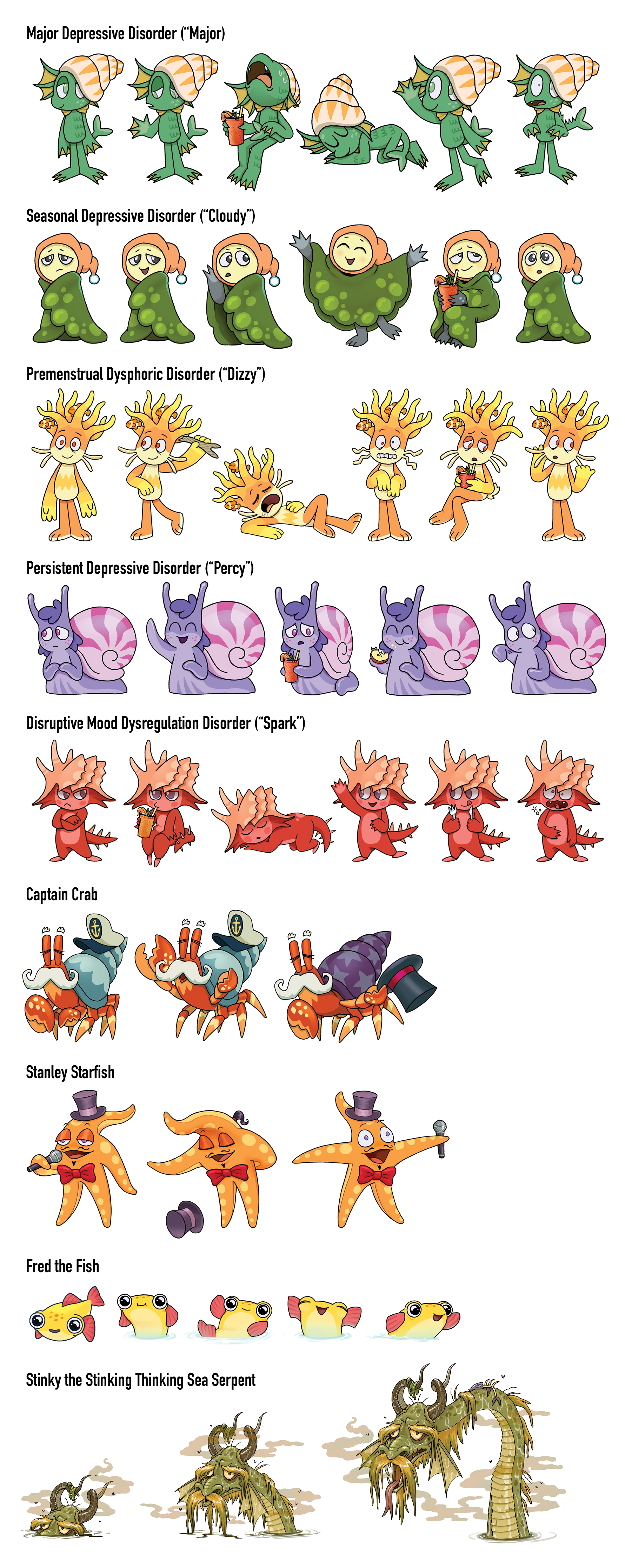Backpack Healthcare
I worked as the character designer for Backpack, a pediatric healthcare firm, as they developed their self-care bibliotherapy app.
Bibliotherapy is a therapeutic model that uses literature and storytelling to help people improve their mental health. The app basically provides interactive digital storybooks that help kids learn about how to cope with and manage their mental health conditions.
I designed characters for the storytelling app, as well as props, icons, and other illustrations. I also created an avatar library with over 1,400 assets for kids to design their own personalized characters.
Background Art by Susi Velasquez and Lizard Schroer
Zipp
Zipp is Backpack’s mascot, and the user’s guide through the Bibliotherapy app. They accompany the user, their avatar, and the Condition Characters throughout each story, leading the way and offering tips on how to manage their mental health.
Above you can see some of Zipp’s many poses and expressions, as well as a few early design concepts. The Backpack team was initially torn between a zipper or a keychain design (they wanted something that would be found on a backpack), but ended up choosing the current zipper design for its friendliness and versatility.
Depression Character Design
These are characters for the Depression unit of the bibliotherapy app. Each section of Backpack Land has a different theme, and the Depression section is a tropical pier. The condition characters, representing different forms of depression, are themed after sea life. Each condition character has 45-50 different poses and expressions, a few of which are displayed above. I also designed some side characters that the player encounters around the pier.



Meditation Scenes and Healthy Habits
Shown above are some other illustrations I produced for the Depression section of Backpack Land. I got to experiment with the art style of these a bit since they were for standalone image galleries.
ADHD Character Design
The ADHD section of Backpack Land is called Wanderland, and is based off of Lewis Carroll’s Alice’s Adventures in Wonderland.
The scenery for this world featured lots of whimsical colors, plants, and mushrooms, so the condition characters are designed to match those themes. There are also some side characters who came from the original text—it was important to make sure that these character designs were solely based off of their original literary descriptions and did not take inspiration from the Disney movie, which is not yet in the public domain.
Final scene of the book featuring a party at the Mad Hatter’s house
This Map of Wanderland pops up at various times throughout the book, with different overlays and keys each time to guide the player. It is shown here with no overlays.
Pixel art for a minigame in which different behaviors appear in the center of the screen and players must drag them to the appropriate garden. At the end of the game the behaviors bloom into flowers or mushrooms, shown above.
Stickers for a virtual scrapbook minigame
Animals, cakes, and hats for a matching minigame
Bullying Character Design
The Backpack Land section on Bullying is set in an old-west town called Bullyburg. I designed Buckle’O Bill, the sheriff of Bullyburg, as well as the troublesome outlaw Bully the Kid and both of their trusty steeds. Unfortunately the art team’s work was outsourced overseas while this book was in progress, so these designs will probably not be used in the final app.
Below are some early character concepts for the townspeople of Bullyburg, all based on North American desert wildlife.
Avatar Library
Backpack wanted their bibliotherapy app users to be able to design a personal avatar to reflect their real-life appearance. This avatar would accompany Zipp and the condition characters throughout every book as a way to bring the user into the story. The user can customize their avatar’s skin color, facial features, clothing, hair, and accessories, which required the creaton of an asset library of over 1,400 images.
Hairstyles for the avatar library. The user could pick from 20 different colors for the hair and accessories; red is shown above.













































































